Microstructural Changes and Strengthening of Austenitic Stainless Steels during Rolling at 473 K
Abstract
1. Introduction
2. Materials and Methods
3. Results
3.1. Microstructural Evolution
3.2. Tensile Behavior
4. Discussion
4.1. Grain Refinement
4.2. Strengthening Mechanisms
5. Conclusions
- Rolling is accompanied by the concurrent operation of deformation twinning, microshear banding and partial martensitic transformation with different kinetics. The 316L steel is more stable against martensitic transformation than 304L steel. The martensite fractions comprise 0.25 in the 304L steel and only 0.03 in the 316L steel after rolling to a total strain of 3.
- Large strain rolling leads to the development of ultrafine grains, which evolve heterogeneously in the microstructural portions with high density of mutually crossed deformation twins, microshear bands, and martensite lamellas. The strain dependence of the fraction of ultrafine grains (FUFG) can be expressed by a modified Johnson-Mehl-Avrami-Kolmogorov equation as FUFG = 1 − exp(−kεn*), where k and n* are constants. In turn, the mean grain size (Dε) can be expressed as Dε = DUFG (FUFG)−0.5, where DUFG can be taken as a final minimal size of ultrafine grains.
- The development of ultrafine grained microstructures with high dislocation density during rolling at 473 K results in significant strengthening. The yield strength increased from 220–230 MPa in the original annealed state to 1350 and 1240 MPa in 304L and 316L steels after rolling to a total strain of 3, respectively. The yield strength (σ0.2) can be expressed by modified Hall-Petch type relationship including the grain size and dislocation strength contributors, which can be expressed through true total strain. The dislocation strengthening provides the main contribution to the yield strength, although the difference between the grain size and dislocation density strengthening decreases with an increase in total strain.
Author Contributions
Funding
Conflicts of Interest
References
- Lo, K.H.; Shek, C.H.; Lai, J.K.L. Recent developments in stainless steels. Mater. Sci. Eng. R Rep. 2009, 65, 39–104. [Google Scholar] [CrossRef]
- Venkatsurya, P.; Thein-Han, W.; Misra, R.; Somani, M.; Karjalainen, L. Advancing nanograined/ultrafine-grained structures for metal implant technology: Interplay between grooving of nano/ultrafine grains and cellular response. Mater. Sci. Eng. C 2010, 30, 1050–1059. [Google Scholar] [CrossRef]
- Martienssen, W.; Warlimont, H. Springer Handbook of Condensed Matter and Materials Data; Springer: Berlin, Germany, 2005. [Google Scholar]
- Valiev, R.Z.; Islamgaliev, R.K.; Alexandrov, I.V. Bulk nanostructured materials from severe plastic deformation. Prog. Mater. Sci. 2000, 45, 103–189. [Google Scholar] [CrossRef]
- Valiev, R. Nanostructuring of metals by severe plastic deformation for advanced properties. Nat. Mater. 2004, 3, 511–516. [Google Scholar] [CrossRef] [PubMed]
- Estrin, Y.; Vinogradov, A. Extreme grain refinement by severe plastic deformation: A wealth of challenging science. Acta Mater. 2013, 61, 782–817. [Google Scholar] [CrossRef]
- Valiev, R.Z.; Zhilyaev, A.P.; Langdon, T.G. Bulk Nanostructured Materials: Fundamentals and Applications; John Wiley & Sons: Hoboken, NJ, USA, 2013. [Google Scholar]
- Sabirov, I.; Enikeev, N.; Murashkin, M.Y.; Valiev, R.Z. Bulk Nanostructured Materials with Multifunctional Properties; Springer: Berlin, Germany, 2015. [Google Scholar]
- Belyakov, A.; Odnobokova, M.; Kipelova, A.; Tsuzaki, K.; Kaibyshev, R. Nanocrystalline structures and tensile properties of stainless steels processed by severe plastic deformation. IOP Conf. Ser. Mater. Sci. Eng. 2014, 63, 012156. [Google Scholar] [CrossRef]
- Odnobokova, M.; Belyakov, A.; Kaibyshev, R. Effect of Severe Cold or Warm Deformation on Microstructure Evolution and Tensile Behavior of a 316L Stainless Steel. Adv. Eng. Mater. 2015, 17, 1812–1820. [Google Scholar] [CrossRef]
- Odnobokova, M.; Belyakov, A.; Kaibyshev, R. Development of Nanocrystalline 304L Stainless Steel by Large Strain Cold Working. Metals 2015, 5, 656–668. [Google Scholar] [CrossRef]
- Shakhova, I.; Belyakov, A.; Yanushkevich, Z.; Tsuzaki, K.; Kaibyshev, R. On Strengthening of Austenitic Stainless Steel by Large Strain Cold Working. ISIJ Int. 2016, 56, 1289–1296. [Google Scholar] [CrossRef]
- Li, J.; Gao, B.; Huang, Z.; Zhou, H.; Mao, Q.; Li, Y. Design for strength-ductility synergy of 316L stainless steel with heterogeneous lamella structure through medium cold rolling and annealing. Vacuum 2018, 157, 128–135. [Google Scholar] [CrossRef]
- Sun, G.; Du, L.; Hu, J.; Zhang, B.; Misra, R. On the influence of deformation mechanism during cold and warm rolling on annealing behavior of a 304 stainless steel. Mater. Sci. Eng. A 2019, 746, 341–355. [Google Scholar] [CrossRef]
- Odnobokova, M.; Belyakov, A.; Kaibyshev, R. Grain refinement and strengthening of austenitic stainless steels during large strain cold rolling. Philos. Mag. 2019, 99, 531–556. [Google Scholar] [CrossRef]
- Sohrabi, M.J.; Mirzadeh, H.; Dehghanian, C. Significance of Martensite Reversion and Austenite Stability to the Mechanical Properties and Transformation-Induced Plasticity Effect of Austenitic Stainless Steels. J. Mater. Eng. Perform. 2020, 29, 3233–3242. [Google Scholar] [CrossRef]
- Lei, C.; Li, X.; Deng, X.; Wang, Z. Microstructural Evolution and Microstructure–Mechanical Property Correlation in Nano/ultrafine-Grained Fe-17Cr-6Ni Austenitic Steel. Metall. Mater. Trans. A 2018, 49, 6134–6146. [Google Scholar] [CrossRef]
- Kumar, B.R.; Sharma, S.; Mahato, B. Formation of ultrafine grained microstructure in the austenitic stainless steel and its impact on tensile properties. Mater. Sci. Eng. A 2011, 528, 2209–2216. [Google Scholar] [CrossRef]
- Odnobokova, M.; Yanushkevich, Z.; Kaibyshev, R.; Belyakov, A. On the Strength of a 316L-Type Stainless Steel Subjected to Cold or Warm Rolling Followed by Annealing. Materials 2020, 13, 2116. [Google Scholar] [CrossRef]
- Yanushkevich, Z.; Dobatkin, S.V.; Belyakov, A.; Kaibyshev, R. Hall-Petch relationship for austenitic stainless steels processed by large strain warm rolling. Acta Mater. 2017, 136, 39–48. [Google Scholar] [CrossRef]
- Hall, E. The deformation and ageing of mild steel: II characteristics of the Lüders deformation. Proc. Phys. Soc. Sect. B 1951, 64, 742. [Google Scholar] [CrossRef]
- Petch, N. The cleavage strength of polycrystals. J. Iron Steel Inst. 1953, 174, 25–28. [Google Scholar]
- Mecking, H.; Kocks, U. Kinetics of flow and strain-hardening. Acta Metall. 1981, 29, 1865–1875. [Google Scholar] [CrossRef]
- Estrin, Y.; Toth, L.; Molinari, A.; Bréchet, Y. A dislocation-based model for all hardening stages in large strain deformation. Acta Mater. 1998, 46, 5509–5522. [Google Scholar] [CrossRef]
- Hughes, D.A.; Hansen, N. Microstructure and strength of nickel at large strains. Acta Mater. 2000, 48, 2985–3004. [Google Scholar] [CrossRef]
- Hansen, N. Hall-Petch relation and boundary strengthening. Scr. Mater. 2004, 51, 801–806. [Google Scholar] [CrossRef]
- Yanushkevich, Z.; Mogucheva, A.; Tikhonova, M.; Belyakov, A.; Kaibyshev, R. Structural strengthening of an austenitic stainless steel subjected to warm-to-hot working. Mater. Charact. 2011, 62, 432–437. [Google Scholar] [CrossRef]
- Morozova, A.; Kaibyshev, R. Grain refinement and strengthening of a Cu–0.1Cr–0.06Zr alloy subjected to equal channel angular pressing. Philos. Mag. 2017, 97, 2053–2076. [Google Scholar] [CrossRef]
- Kusakin, P.; Belyakov, A.; Kaibyshev, R.; Molodov, D. Modeling the effect of deformation on strength of a Fe-23Mn-0.3 C-1.5 Al TWIP steel. IOP Conf. Ser. Mater. Sci. Eng. 2014, 63, 012059. [Google Scholar] [CrossRef]
- Schramm, R.E.; Reed, R.P. Stacking fault energies of seven commercial austenitic stainless steels. Metall. Trans. A 1975, 6, 1345–1351. [Google Scholar] [CrossRef]
- De Bellefon, G.M.; van Duysen, J.; Sridharan, K. Composition-dependence of stacking fault energy in austenitic stainless steels through linear regression with random intercepts. J. Nucl. Mater. 2017, 492, 227–230. [Google Scholar] [CrossRef]
- Winther, G.; Huang, X.; Godfrey, A.; Hansen, N. Critical comparison of dislocation boundary alignment studied by TEM and EBSD: Technical issues and theoretical consequences. Acta Mater. 2004, 52, 4437–4446. [Google Scholar] [CrossRef]
- Lü, Y.; Molodov, D.A.; Gottstein, G. Correlation between microstructure and texture development in a cold-rolled TWIP steel. ISIJ Int. 2011, 51, 812–817. [Google Scholar] [CrossRef]
- Kusakin, P.; Belyakov, A.; Haase, C.; Kaibyshev, R.; Molodov, D.A. Microstructure evolution and strengthening mechanisms of Fe–23Mn–0.3 C–1.5 Al TWIP steel during cold rolling. Mater. Sci. Eng. A 2014, 617, 52–60. [Google Scholar] [CrossRef]
- Yanushkevich, Z.; Belyakov, A.; Haase, C.; Molodov, D.A.; Kaibyshev, R. Structural/textural changes and strengthening of an advanced high-Mn steel subjected to cold rolling. Mater. Sci. Eng. A 2016, 651, 763–773. [Google Scholar] [CrossRef]
- Miura, H.; Kobayashi, M.; Todaka, Y.; Watanabe, C.; Aoyagi, Y.; Sugiura, N.; Yoshinaga, N. Heterogeneous nanostructure developed in heavily cold-rolled stainless steels and the specific mechanical properties. Scr. Mater. 2017, 133, 33–36. [Google Scholar] [CrossRef]
- Nakada, N.; Ito, H.; Matsuoka, Y.; Tsuchiyama, T.; Takaki, S. Deformation-induced martensitic transformation behavior in cold-rolled and cold-drawn type 316 stainless steels. Acta Mater. 2010, 58, 895–903. [Google Scholar] [CrossRef]
- He, Y.; Godet, S.; Jonas, J.J. Observations of the Gibeon meteorite and the inverse Greninger–Troiano orientation relationship. J. Appl. Crystallogr. 2006, 39, 72–81. [Google Scholar] [CrossRef]
- Landheer, H.; Offerman, S.E.; Petrov, R.H.; Kestens, L.A.I. The Role of α/γ Orientation Relationships during Ferrite Nucleation in an Fe-Cr-Ni Alloy. Mater. Sci. Forum 2007, 558–559, 1413–1418. [Google Scholar] [CrossRef]
- Shakhova, I.; Dudko, V.; Belyakov, A.; Tsuzaki, K.; Kaibyshev, R. Effect of large strain cold rolling and subsequent annealing on microstructure and mechanical properties of an austenitic stainless steel. Mater. Sci. Eng. A 2012, 545, 176–186. [Google Scholar] [CrossRef]
- Olson, G.; Cohen, M. Kinetics of nucleation strain-induced martensitic. Met. Mater Trans. A 1975, 6, 791–795. [Google Scholar] [CrossRef]
- Odnobokova, M.; Belyakov, A.; Kaibyshev, R. Deformation microstructures and mechanical properties of an austenitic stainless steel subjected to warm rolling. Mater. Sci. Forum 2017, 879, 1414–1419. [Google Scholar] [CrossRef]
- Mackenzie, J. Second paper on statistics associated with the random disorientation of cubes. Biometrika 1958, 45, 229–240. [Google Scholar] [CrossRef]
- Kolmogorov, A.N. On the statistical theory of the crystallization of metals. Bull. Acad. Sci. USSR Math. Ser. 1937, 1, 355–359. [Google Scholar]
- Johnson, W.A. Reaction kinetics in processes of nucleation and growth. Am. Inst. Min. Met. Petro. Eng. 1939, 135, 416–458. [Google Scholar]
- Avrami, M. Kinetics of Phase Change. I General Theory. J. Chem. Phys. 1939, 7, 1103–1112. [Google Scholar] [CrossRef]
- Starink, M.J. Dislocation versus grain boundary strengthening in SPD processed metals: Non-causal relation between grain size and strength of deformed polycrystals. Mater. Sci. Eng. A 2017, 705, 42–45. [Google Scholar] [CrossRef]
- De Cooman, B.C.; Estrin, Y.; Kim, S.K. Twinning-induced plasticity (TWIP) steels. Acta Mater. 2018, 142, 283–362. [Google Scholar] [CrossRef]
- Belyakov, A.; Sakai, T.; Miura, H. Fine-grained structure formation in austenitic stainless steel under multiple deformation at 0.5 Tm. Mater. Trans. JIM 2000, 41, 476–484. [Google Scholar] [CrossRef][Green Version]
- Hansen, N.; Huang, X.; Ueji, R.; Tsuji, N. Structure and strength after large strain deformation. Mater. Sci. Eng. A 2004, 387, 191–194. [Google Scholar] [CrossRef]
- Khamsuk, S.; Park, N.; Gao, S.; Terada, D.; Adachi, H.; Tsuji, N. Mechanical properties of bulk ultrafine grained aluminum fabricated by torsion deformation at various temperatures and strain rates. Mater. Trans. 2014, 55, 106–113. [Google Scholar] [CrossRef]
- Young, C.; Sherby, O. Sub-grain formation and sub-grain-boundary strengthening in Fe-based materials. J. Iron Steel Inst. 1973, 211, 640–647. [Google Scholar]

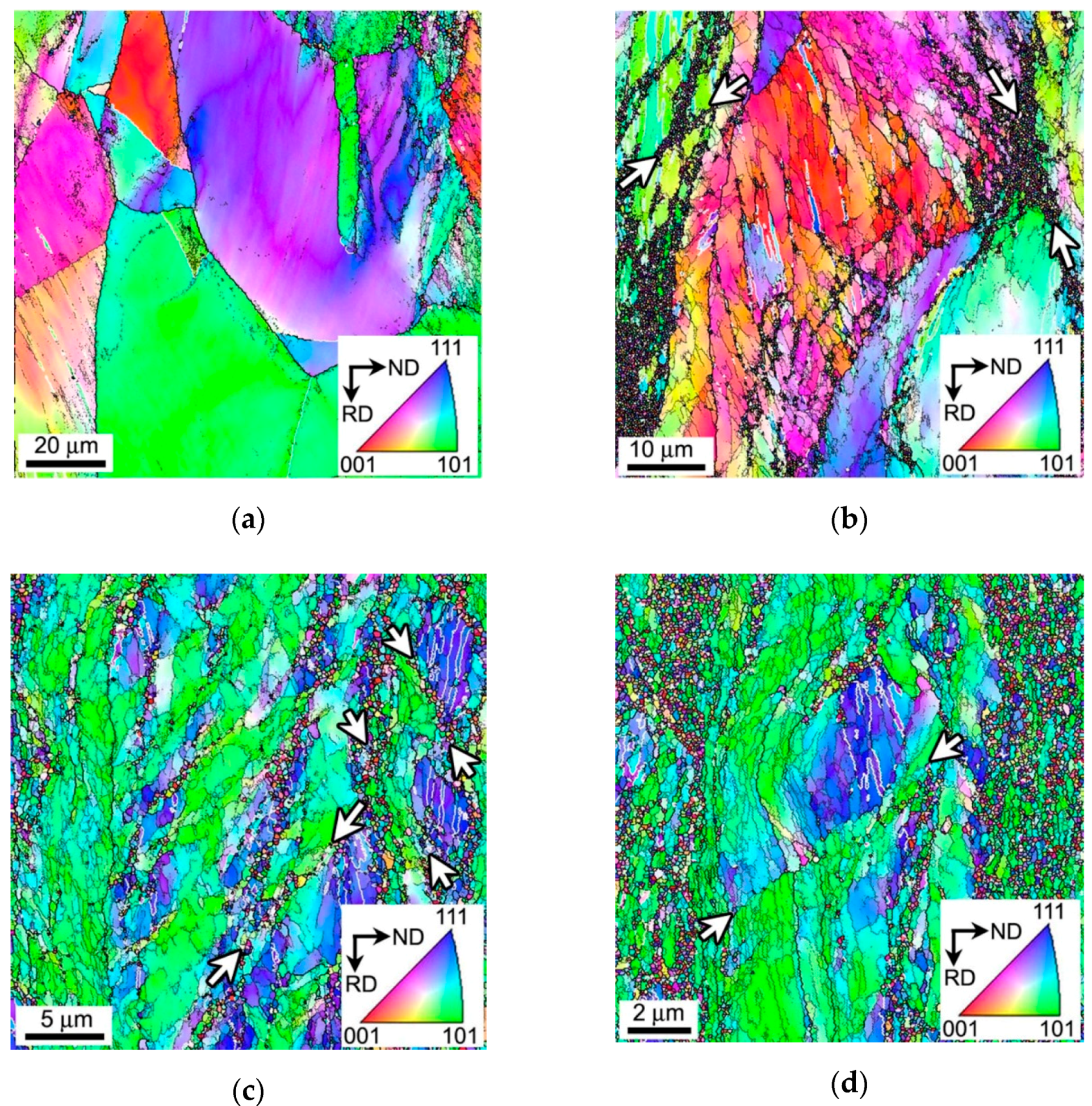
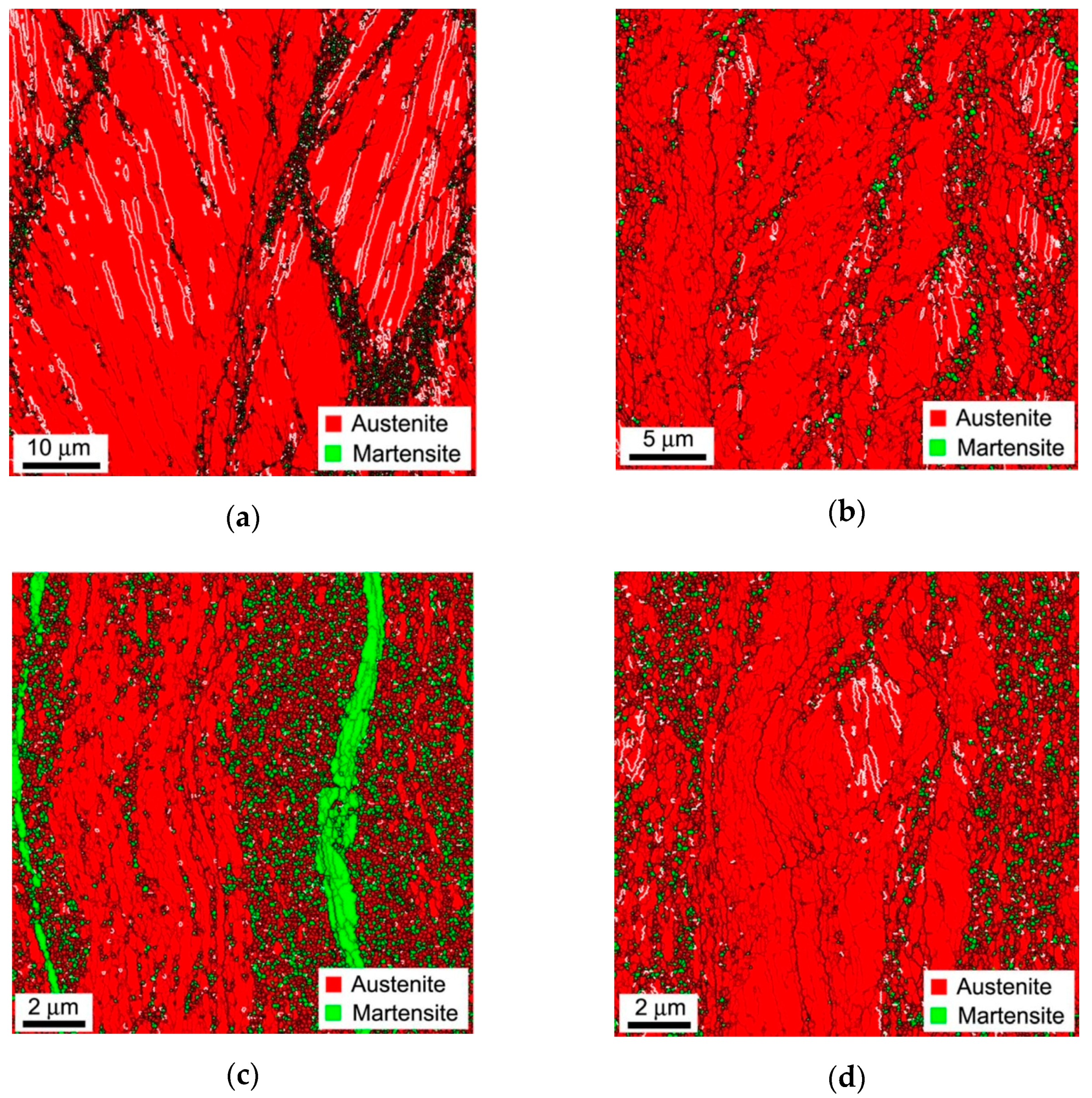

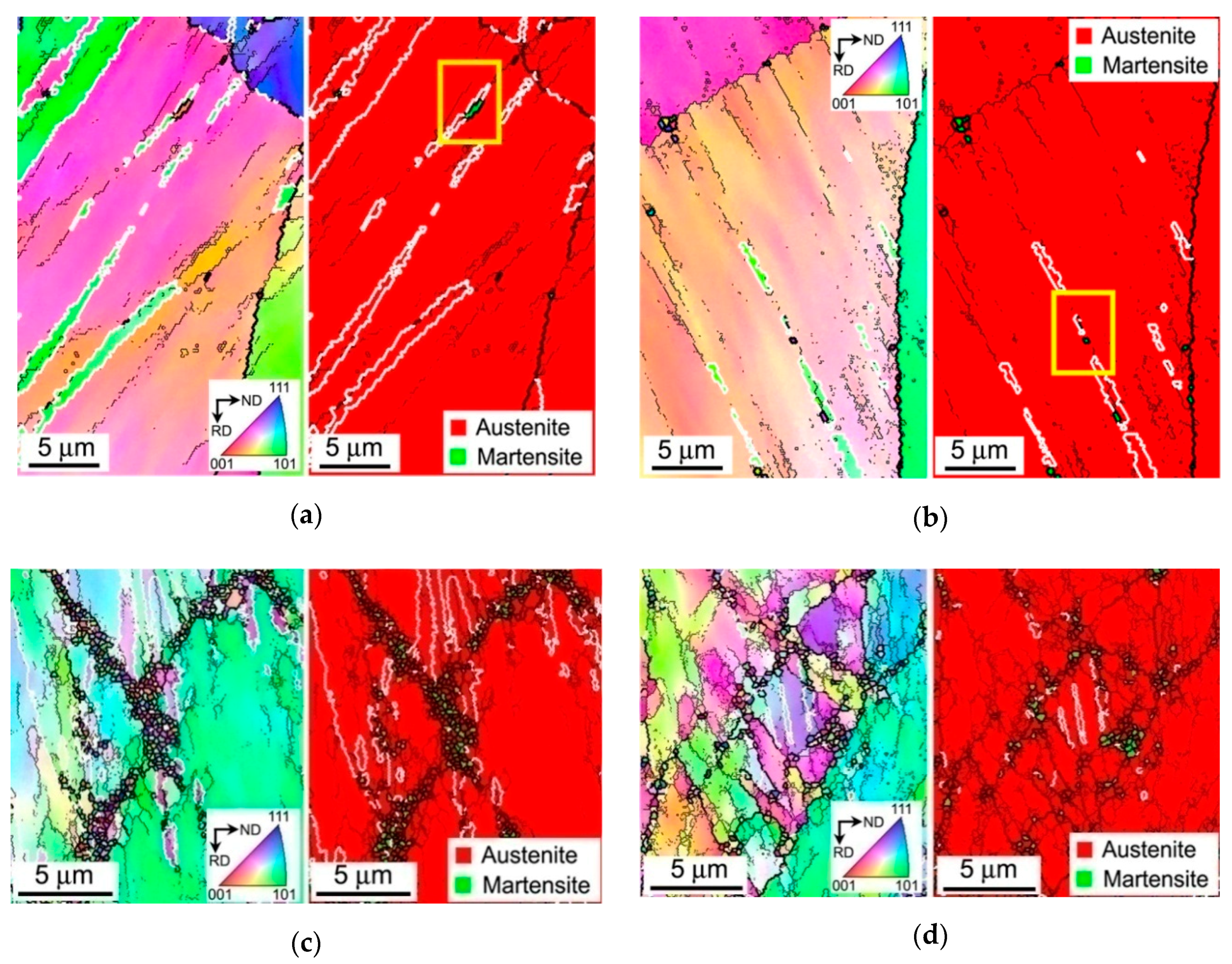
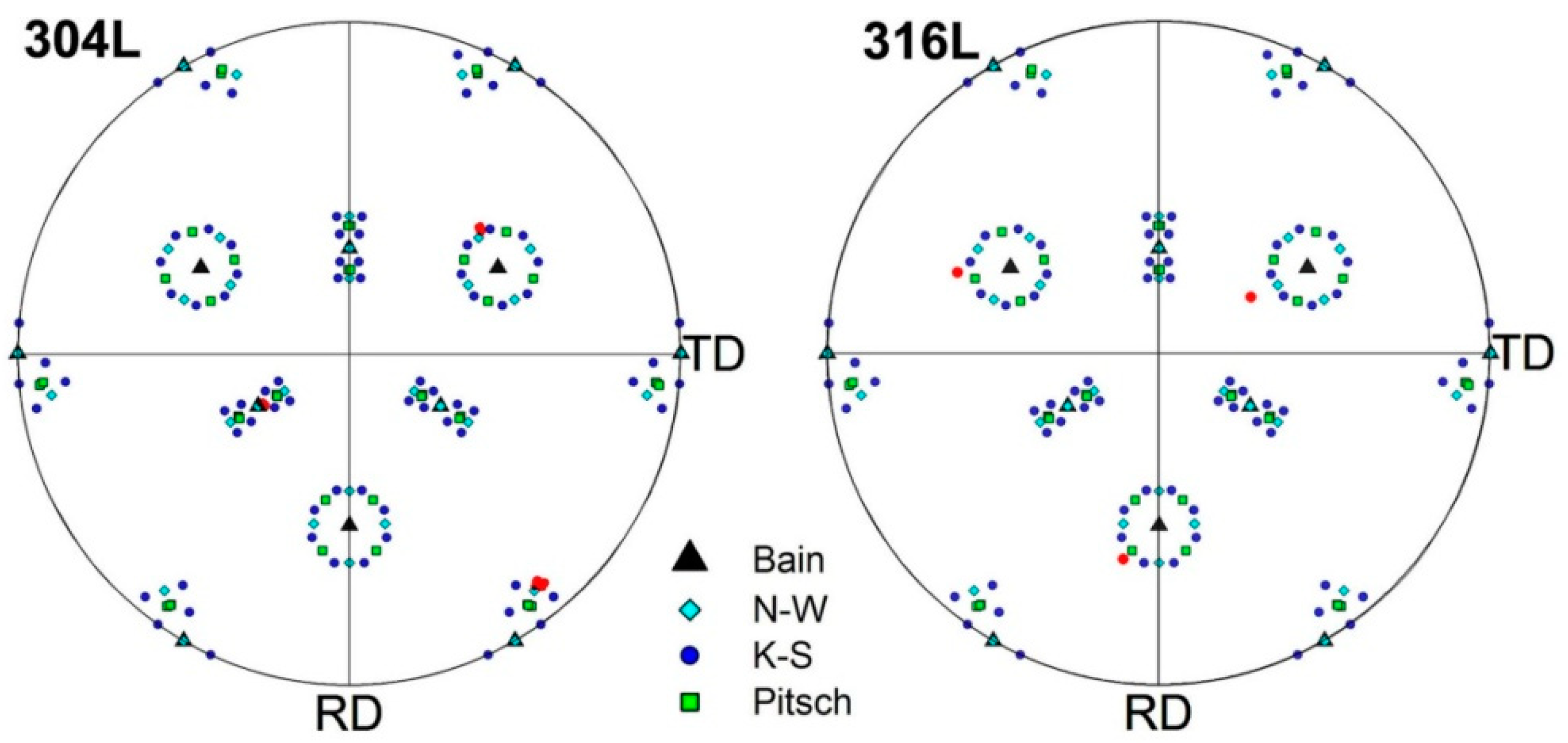

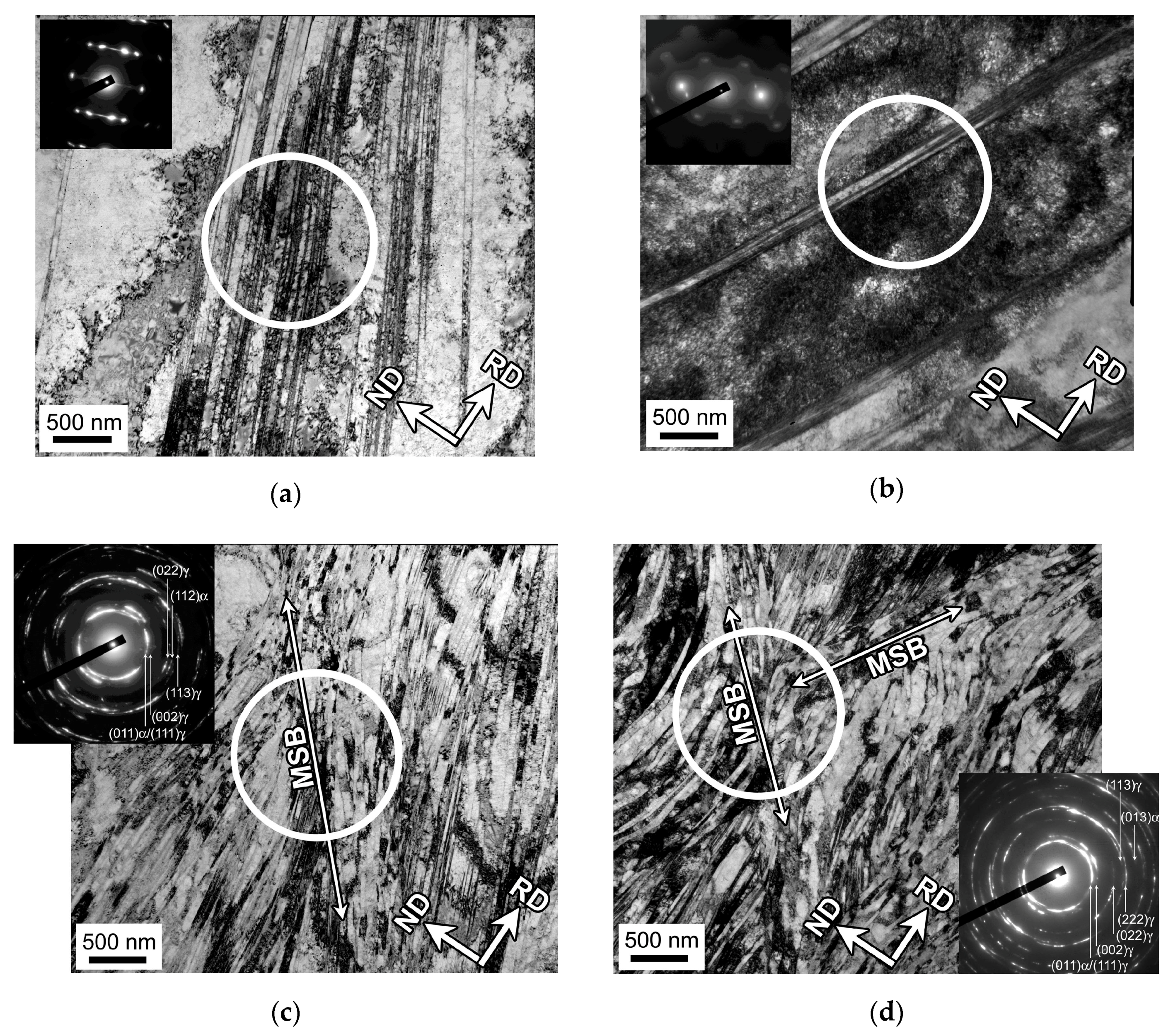
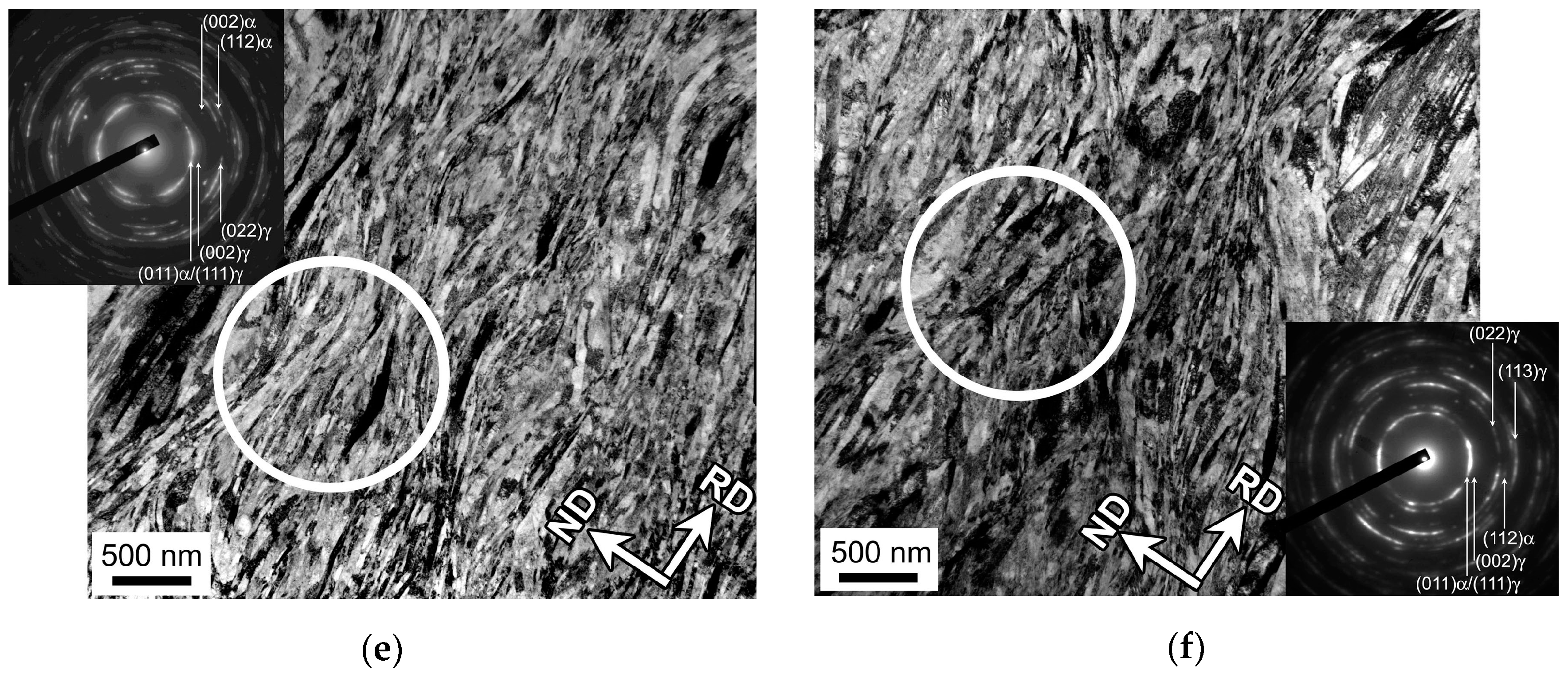
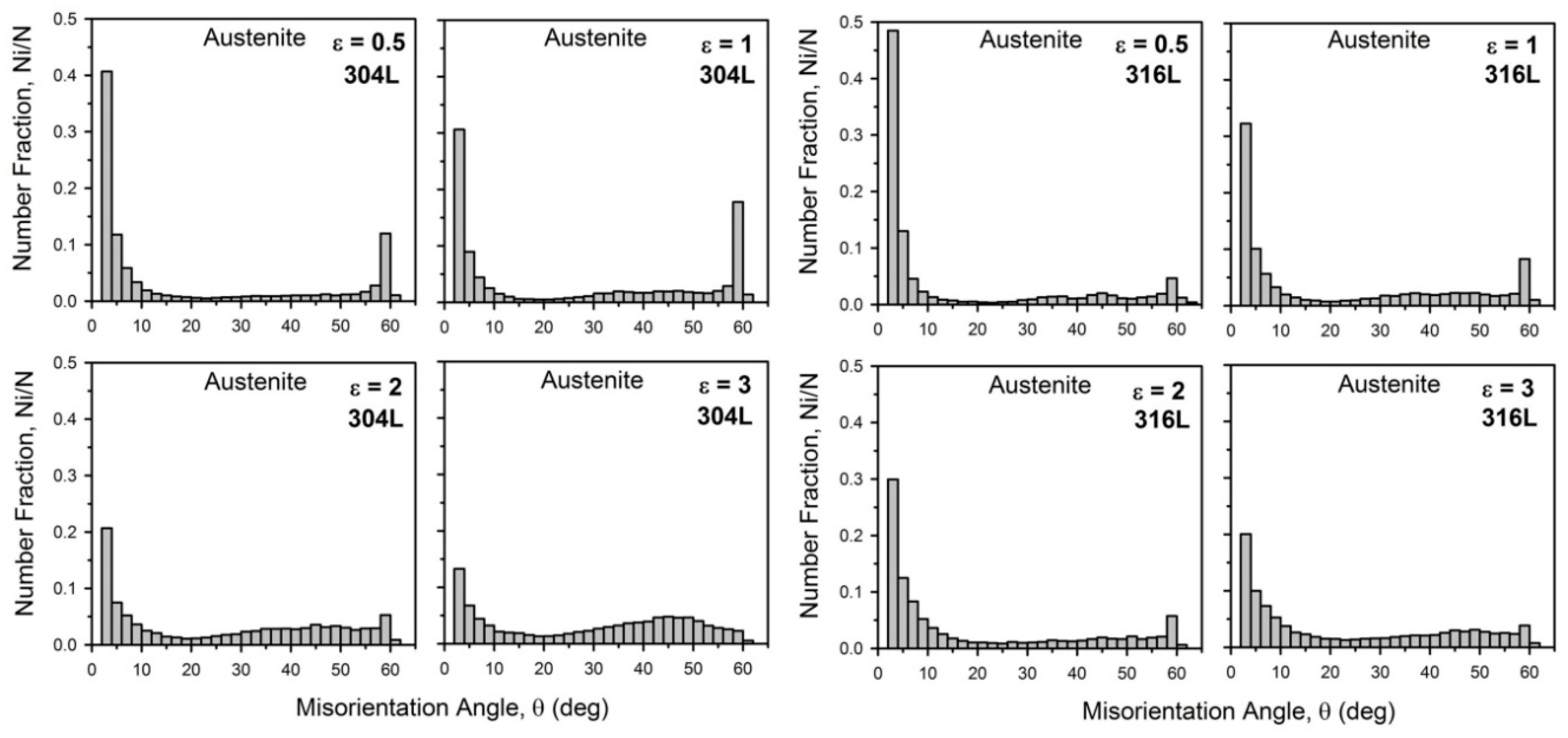
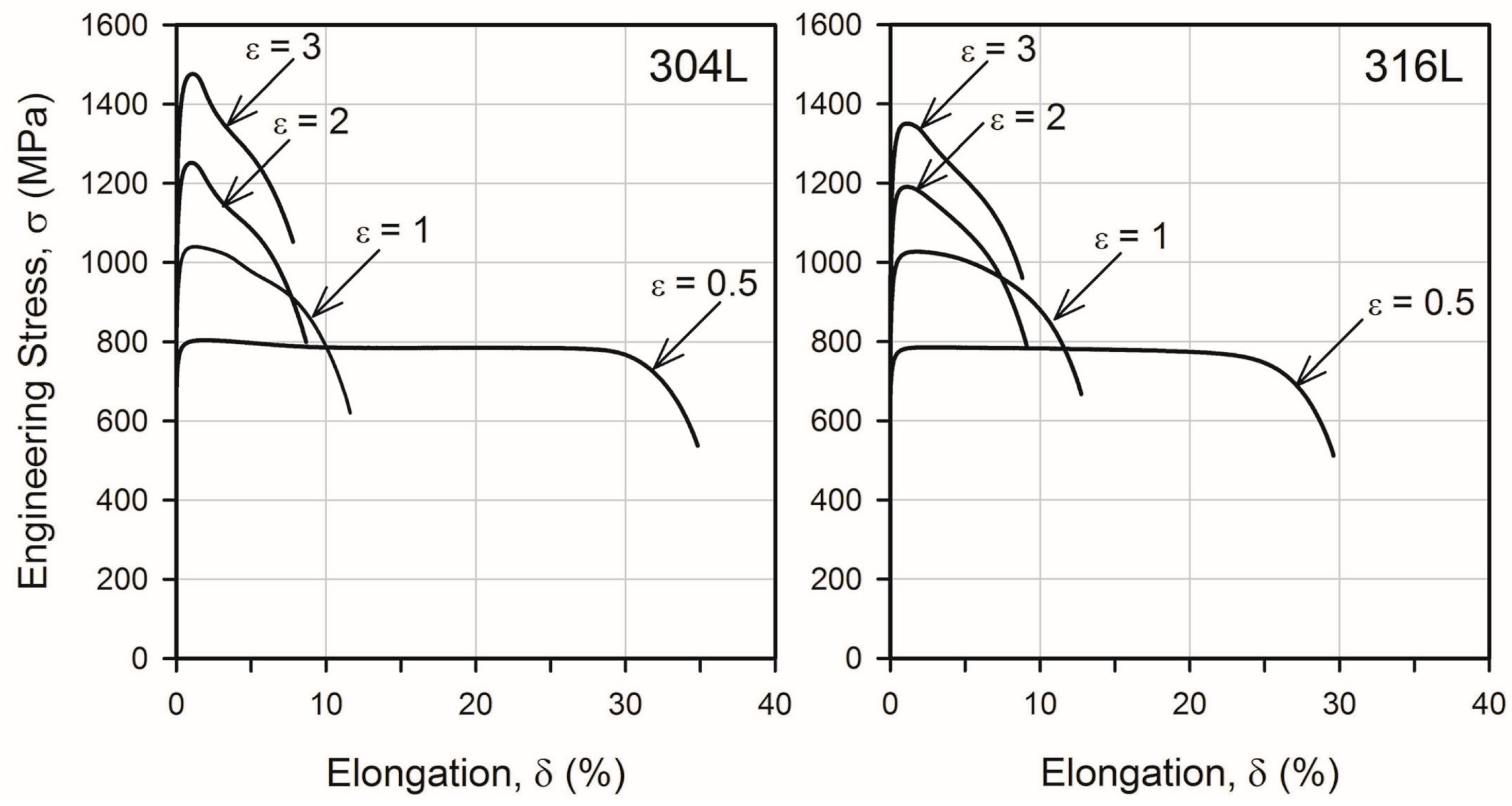


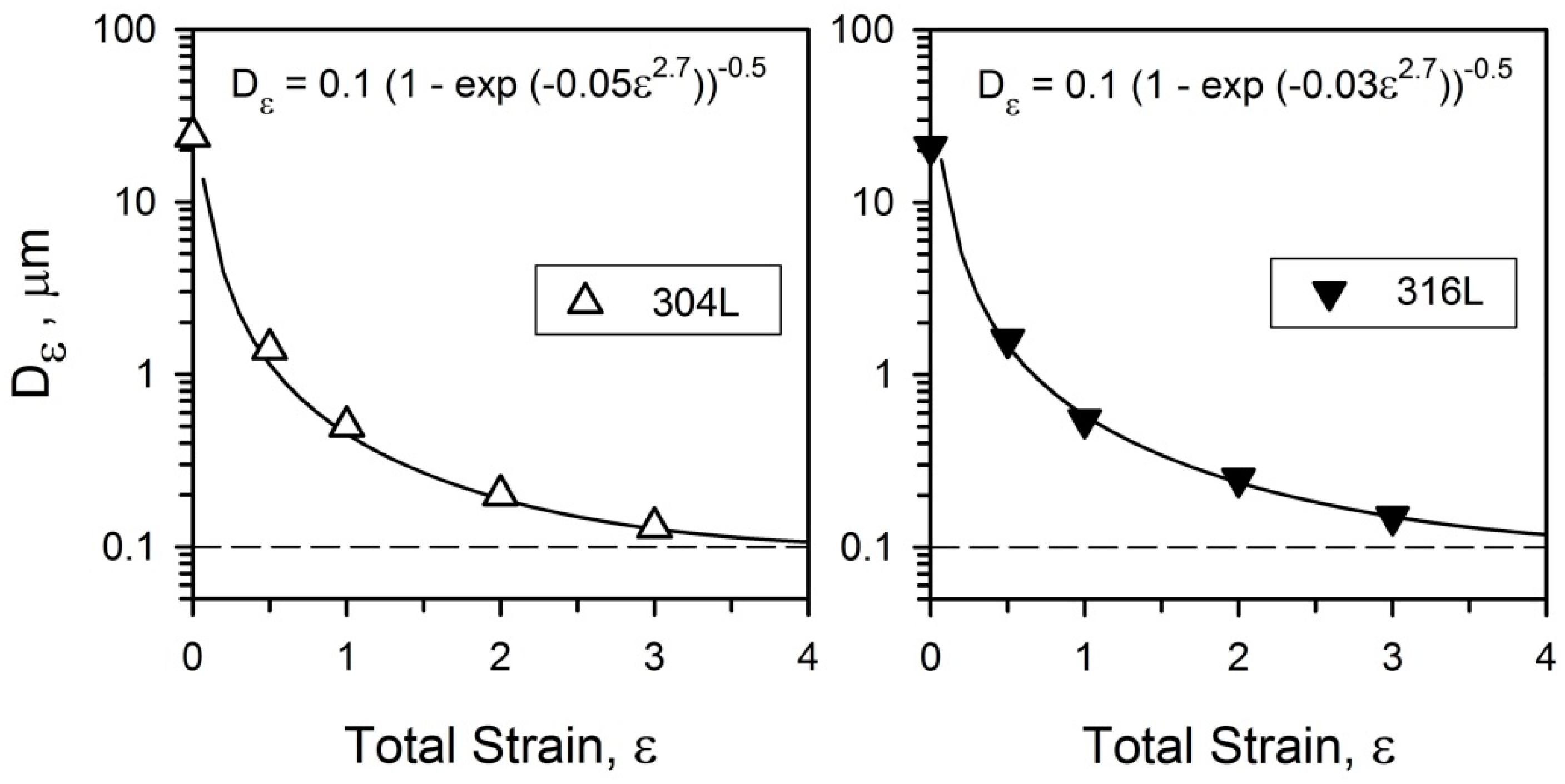
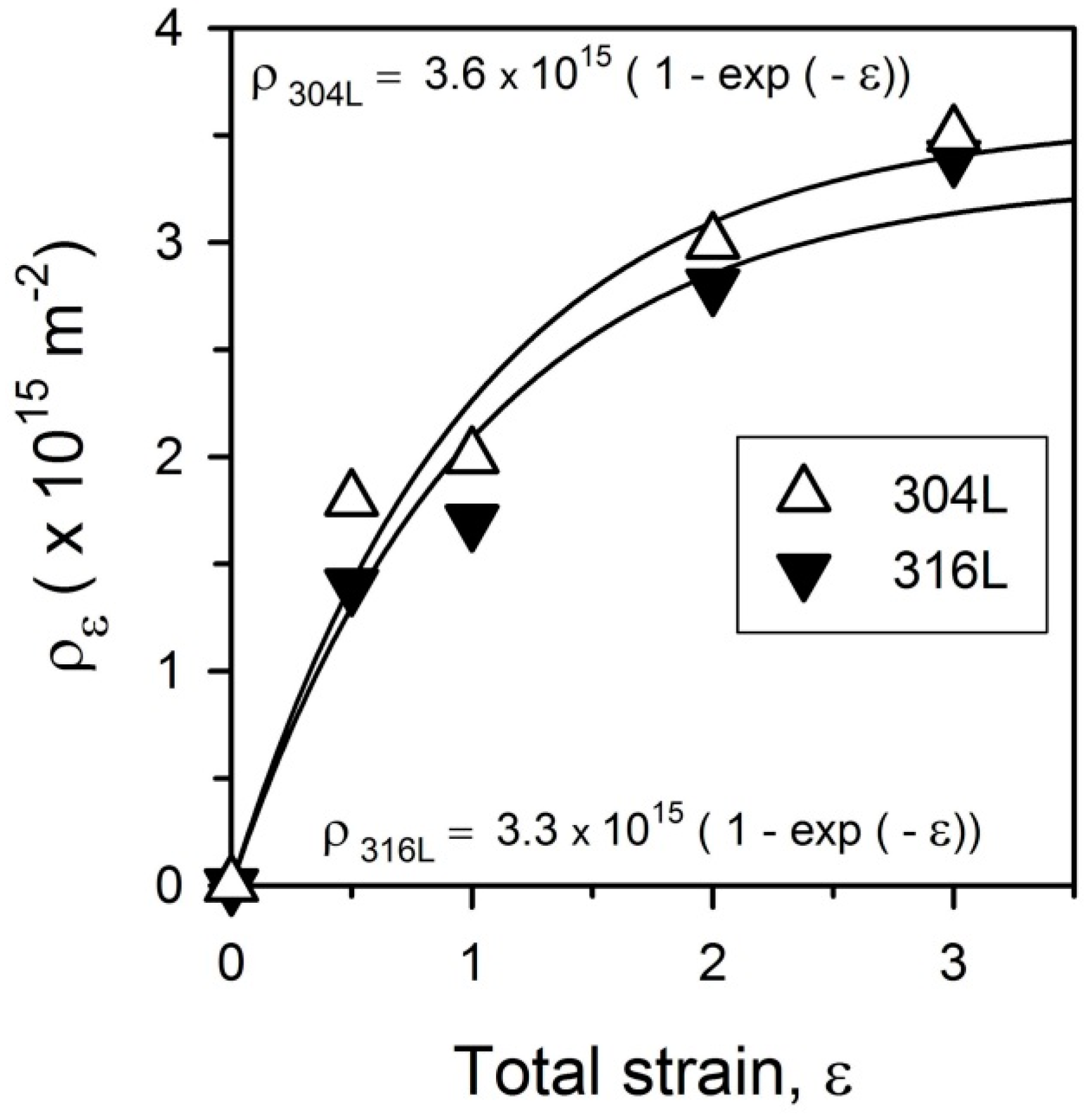
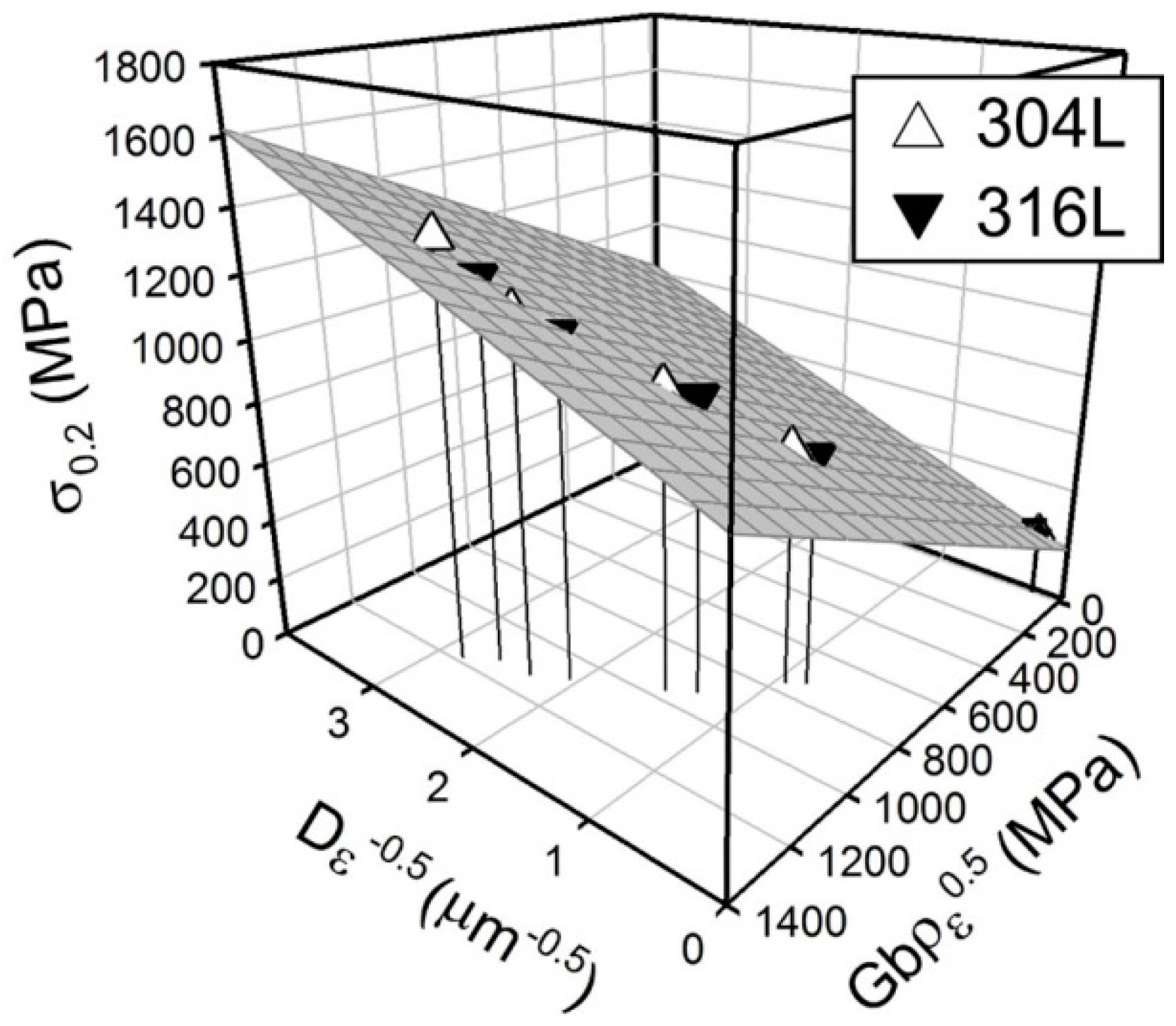
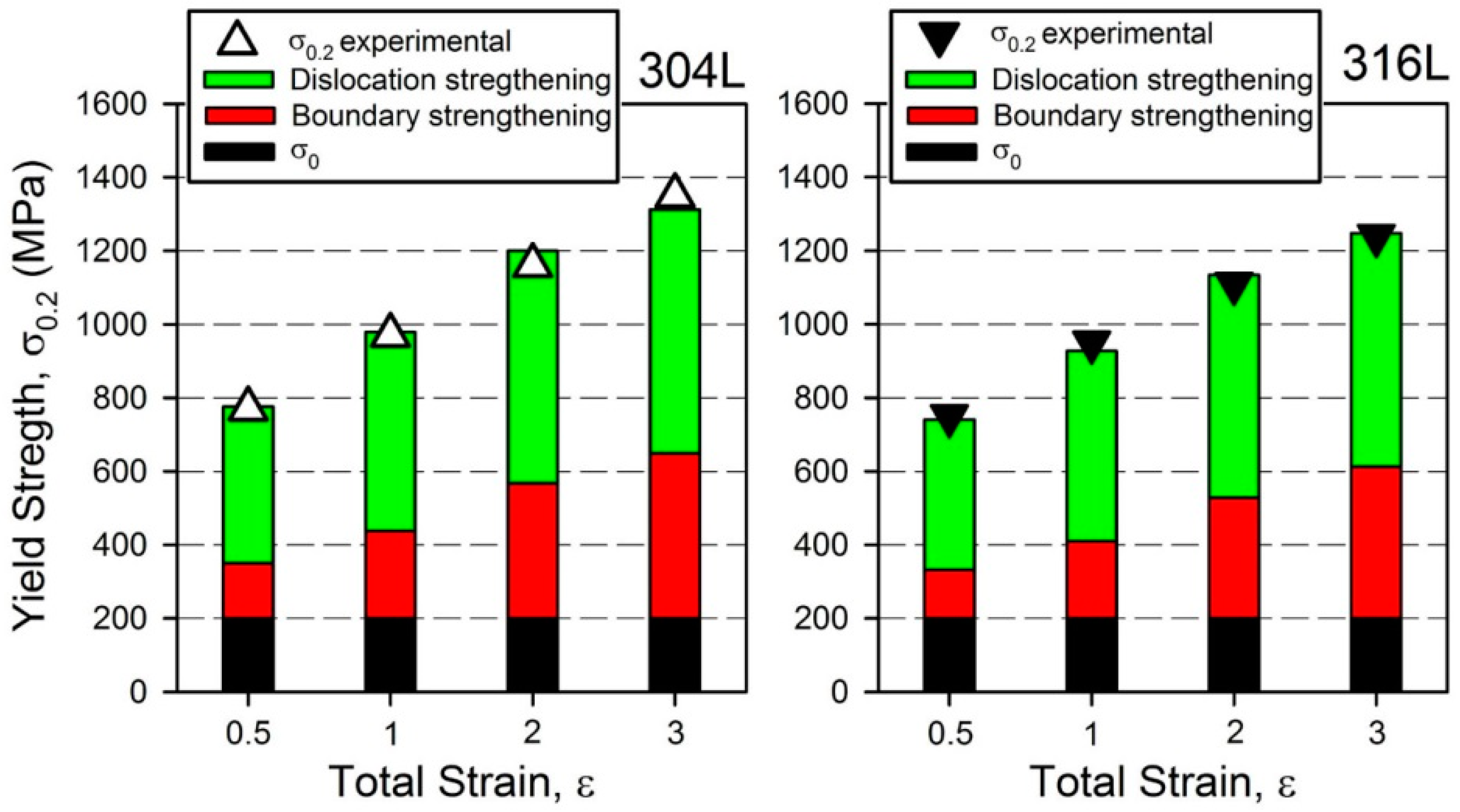
| Element[wt.%] | Fe | C | Cr | Ni | Mn | Mo | Si | P | S |
|---|---|---|---|---|---|---|---|---|---|
| 304L | Bal. | 0.05 | 18.2 | 8.8 | 1.65 | 0.5 | 0.43 | 0.05 | 0.04 |
| 316L | Bal. | 0.04 | 17.3 | 10.7 | 1.7 | 2 | 0.4 | 0.04 | 0.05 |
| Condition | D, μm | ρ, 1015 m−2 | FM, % | σ0.2, MPa | UTS, MPa | δ, % |
|---|---|---|---|---|---|---|
| Initial (304L) | 24 ± 4 | 0.002 ± 0.001 | - | 220 ± 20 | 600 ± 20 | 100 ± 3 |
| ε = 0.5 (304L) | 1.4 ± 0.4 | 1.8 ± 0.4 | 0.9 ± 0.7 | 770 ± 30 | 800 ± 20 | 35 ± 3 |
| ε = 1 (304L) | 0.5 ± 0.05 | 2 ± 0.3 | 2.3 ± 0.9 | 970 ± 20 | 1040 ± 20 | 12 ± 2 |
| ε = 2 (304L) | 0.2 ± 0.05 | 3 ± 0.2 | 15.3 ± 2.8 | 1160 ± 10 | 1250 ± 10 | 9 ± 2 |
| ε = 3 (304L) | 0.13 ± 0.03 | 3.5 ± 0.2 | 24.6 ± 2.7 | 1350 ± 10 | 1480 ± 10 | 8 ± 2 |
| Initial (316L) | 21 ± 4 | 0.002 ± 0.001 | - | 235 ± 20 | 585 ± 20 | 86 ± 3 |
| ε = 0.5 (316L) | 1.6 ± 0.4 | 1.4 ± 0.4 | 0.3 ± 0.3 | 750 ± 30 | 790 ± 20 | 30 ± 3 |
| ε = 1 (316L) | 0.55 ± 0.05 | 1.7 ± 0.3 | 0.33 ± 0.3 | 950 ± 20 | 1030 ± 20 | 13 ± 2 |
| ε = 2 (316L) | 0.25 ± 0.05 | 2.8 ± 0.2 | 1.83 ± 0.5 | 1110 ± 10 | 1190 ± 10 | 9 ± 2 |
| ε = 3 (316L) | 0.15 ± 0.03 | 3.4 ± 0.2 | 2.6 ± 0.3 | 1240 ± 10 | 1350 ± 10 | 9 ± 2 |
Publisher’s Note: MDPI stays neutral with regard to jurisdictional claims in published maps and institutional affiliations. |
© 2020 by the authors. Licensee MDPI, Basel, Switzerland. This article is an open access article distributed under the terms and conditions of the Creative Commons Attribution (CC BY) license (http://creativecommons.org/licenses/by/4.0/).
Share and Cite
Odnobokova, M.; Belyakov, A.; Enikeev, N.; Kaibyshev, R.; Valiev, R.Z. Microstructural Changes and Strengthening of Austenitic Stainless Steels during Rolling at 473 K. Metals 2020, 10, 1614. https://doi.org/10.3390/met10121614
Odnobokova M, Belyakov A, Enikeev N, Kaibyshev R, Valiev RZ. Microstructural Changes and Strengthening of Austenitic Stainless Steels during Rolling at 473 K. Metals. 2020; 10(12):1614. https://doi.org/10.3390/met10121614
Chicago/Turabian StyleOdnobokova, Marina, Andrey Belyakov, Nariman Enikeev, Rustam Kaibyshev, and Ruslan Z. Valiev. 2020. "Microstructural Changes and Strengthening of Austenitic Stainless Steels during Rolling at 473 K" Metals 10, no. 12: 1614. https://doi.org/10.3390/met10121614
APA StyleOdnobokova, M., Belyakov, A., Enikeev, N., Kaibyshev, R., & Valiev, R. Z. (2020). Microstructural Changes and Strengthening of Austenitic Stainless Steels during Rolling at 473 K. Metals, 10(12), 1614. https://doi.org/10.3390/met10121614








